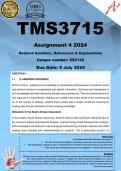Exam (elaborations)
TMS3715 Assignment 4 (COMPLETE ANSWERS) 2024 (652142) - DUE 9 July 2024
- Course
- Institution
- Book
TMS3715 Assignment 4 (COMPLETE ANSWERS) 2024 (652142) - DUE 9 July 2024 ;100% TRUSTED workings, explanations and solutions. for assistance Whats-App ...0.6.7..1.7.1..1.7.3.9 .......QUESTION 1 (50 marks) Use learning unit 6 - Teaching Reading and Viewing to HL Learners in FET to complete the tasks...
[Show more]



